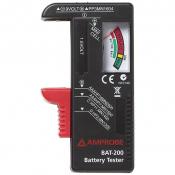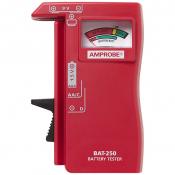Product Comparison: Amprobe BAT-200 vs Amprobe BAT-250
This site is a free online resource that strives to offer helpful content and comparison features to its visitors. Please be advised that the operator of this site accepts advertising compensation from certain companies that appear on the site, and such compensation impacts the location and order in which the companies (and/or their products) are presented, and in some cases may also impact the scoring that is assigned to them. The scoring that appears on this site is determined by the site operator in its sole discretion, and should NOT be relied upon for accuracy purposes. In fact, Company/product listings on this page DO NOT imply endorsement by the site operator. Except as expressly set forth in our Terms of Use, all representations and warranties regarding the information presented on this page are disclaimed. The information which appears on this site is subject to change at any time. More info
- The key functional difference is that the Amprobe meter places a simulated load on the battery when testing it, whereas the D-Fantix does not. I
- This is a pretty simple but effective little product. It does exactly as it's supposed to do, telling you if your batter is good, low, or needs to be replaced.
- This is an inexpensive and rather cheaply made battery tester, but it is a bargain considering the simple task it performs – and its size.
- Plain and simple it works and is well worth the price. A must for anyone who uses regular or rechargeable batteries on a regular basis.
- This is a hand sized battery tester that will test standard household use batteries.
- This battery tester worked Great - just as promised. Tried out on new batteries and they read at the top of the green range, then tested what I assumed were bad batteries and they read in the red (replace) or yellow range.
- Otherwise you may test a fully recharged battery and the tester doesn't go way into the green and you think "this tester doesn't even work right!".
- This little baby has a slot you lay battery in and push the bottom until the battery is automatically touching both contacts. Easy to test 9 volts as well and "coin batteries."
- This does the job very well and is sturdily constructed.
- I checked the accuracy of this tester using numerous batteries of varying remaining voltage. A new 1.5 volt carbon or alkaline battery tests at about 1.6 volts.








- This tester is very easy to use and the display is easy to read.
- I’m right handed & it’s awkward to hold and see display. Honestly it’s much better to see the exact voltage on a digital display.
- This battery tester is very simple to use, easy to read display with color coding. No need to change any settings, the unit knows what the volts should be by the position of the red sliding battery holder.
- The sliding jaw is not spring loaded so you do have to keep pressure upwards with your thumb while testing, not a big deal and it is one less thing that can break (everything in that junk drawer gets jostled around).
- Let me call this a clamp-style tester. It has an analog display.
- I'm getting older and like older people, in general, can't see as well but the Amprobe 250 has a large and easy to read display that is oriented to make results even more simple to read.
- I wish the green section was larger so it would be easier to gauge how good the battery is.
- This one was the easiest to use. It has a groove on the side so the battery doesn't fall out while you're trying to clamp the tester contacts on the battery.
- The display will let you know if the battery is good or if you need to replace it.
- I wish the green section was larger so it would be easier to gauge how good the battery is.
Popular Comparisons








